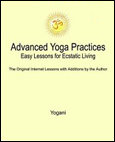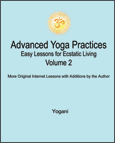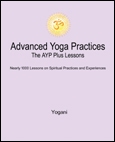|
Public Home | Plus Home | Main Lessons | Tantra Lessons | Public Forum | Plus Forum | Downloads | Books Topic Paths | Search | Training-Retreats | Testimonials | Survey | Interviews | MultiMedia | Contact | Donate |
|
Advanced Yoga Practices Note: For the Original Internet Lessons with additions, see the AYP Easy Lessons Books. For the Expanded and Interactive Internet Lessons, AYP Online Books, Audiobooks and more, see AYP Plus. Lesson 301 - Prayer and the Principles of Samyama (Audio)
AYP Plus Additions:
From: Yogani New Visitors: It is recommended you read from the beginning of the web archive, as previous lessons are prerequisite to this one. The first lesson is, "Why This Discussion?"
Does this sound familiar? It should. It is the application of the principles of samyama. It should not be a surprise. The principles of samyama are universal and are contained within all of us. They are found manifesting in prayer practice in every religious tradition. The principles of samyama are inherent in everyone, and for this reason prayer has been found to work, more or less, for thousands of years. What do we mean by, "Prayer works, more or less"? Certainly, all prayers are not answered to our satisfaction. The more we are externally invested in the particular outcome desired from prayer, the less likely that specific outcome will be forthcoming. This is because the cultivation of expectations for a specific outcome is not true prayer (or samyama). Expectations are external projections of the mind that have little to do with prayer. Our personal desires will short-circuit the divine outflow. On the other hand, it will be a different story if we offer a specific object in our prayers and release it to inner silence (the divine) within us without hanging on to expectations. This will always lead to a result, not necessarily exactly what we expected, but something fruitful all the same. What comes from prayer is a function of our surrender, not our expectation. This is the key point in all prayer. Surrender of the object to the divine is the essential operating principle in prayer. This is beautifully expressed in the Biblical phrase, "Thy will be done." This is not an invitation to lead a passive life without active participation. Real surrender is not passive. It is tremendously dynamic. It is the rise of the active witness. It is the birth of stillness in action. All sorts of miraculous events will flow out of this kind of awakening - this kind of active surrender. Effective prayer is effective relationship with the divine within us. It is dynamic relationship. In this kind of relationship, the attention is brought to many objects, sometimes in structured practice and sometimes spontaneously. With the rise of stillness in action, the natural flow of desires is steadily elevated, and so are the objects selected, which are released into stillness. And the divine flow pours out from within, increasing from its own momentum, like a snowball rolling downhill. Active surrender! Our own activity in daily living is part of this process. We can be very active, pursuing our goals in life, and in surrender at the same time. As a matter of fact, the more active we are in moving toward our goals, the more effective our spiritual practices and prayers will be. There is the expression, "The Lord helps those who help themselves." It is true. This is especially applicable for those who are engaged in daily spiritual practices, because stillness becomes very active, and this means action in the form of outpouring divine energy. When we speak of the object of our prayer, we can apply some additional useful knowledge from the principles of samyama by considering the application of the concept of sutra. Recall that a sutra is a code word or phrase that contains meaning stored deep in our consciousness in the seeds of our language. If we have understood a sutra before we enter samyama practice, we will not have to be understanding it during samyama practice. We just pick it up and let it go. The word or phrase will contain the meaning. This is a highly effective way to release content into stillness, including in prayer. We are shrinking the proverbial camel, so it can pass easily through the eye of the needle into stillness. From there, inner silence will take over. Let's consider a practical example. If we have a dear relative or friend who is ill, we may wish to offer a prayer for them. We know their name, and that they are ill. Deep within us we have the essence of who they are. It is contained deep in our consciousness. So, what is the best way to offer a prayer for this person? Does it have to be a long, drawn out prayer? If so, how would we surrender such a long and drawn out petition into stillness? While our prayer may be rich in words, how can we cram all of that richness through the eye of the needle into stillness? Stillness does not need our elaborate words. More is less in this case. It is much better to do a simple repetition of the person's name, faintly picking it up and releasing it into stillness, letting it go for about 15 seconds, and then touching the name again on the boundary of stillness in a very faint way. Then we can let it go again. And again, for as many times as we feel appropriate, but not to the point of excess and strain. Everything we know about the person and all that is needed to enliven divine healing energy is contained in the simple procedure of releasing their name into divine stillness. We can be certain that divine healing energy will be stirred by our prayer. It is very simple. 5-10 minutes is a good period to engage in a prayer when applied with samyama. It will be very powerful, particularly if we have been cultivating inner silence through deep meditation beforehand. Therefore, a good time to engage in such prayer activity is soon after our sitting practices. If this is not the case, then 5-10 minutes of deep meditation right before prayer will help stabilize a good initial condition of inner silence. If we do this, our prayer will be more powerful. The degree of help that may be received by another is also dependent on the degree of receptivity, so it is good for the person in need to be aware of the prayers being offered on their behalf. Receptivity is the greater half of the equation. If this were not so, sincere prayers would have much greater effect than is often the case. If the recipient is open and receptive, the entire universe will run to fill the need. As has been said, "Your faith has made you whole." It will be a good idea to take some extra rest after doing samyama-style prayer. Keep in mind that while we are helping others, we are also advancing our own inner purification and opening, so some rest afterward is advised to avoid the possibility of some irritability occurring when we get up and go out into our daily activities. The same kind of procedure can be used with traditional prayers, meditating first for 5-10 minutes, and then picking up each phrase or line of our traditional prayer faintly and releasing it into stillness, letting go for about 15 seconds before picking up the next phrase or line. It can be done while using a rosary or mala also. In many traditions, group prayer is used to multiply the effects of individual prayer. When refining our prayer using the principles of samyama, and doing it in a group, the effects can be greatly amplified. It is not mandatory for a prayer group to be physically located in one place. It has been found that a coordinated prayer offered by many people in many locations, synchronized in time, is very powerful in its positive effects. With the advent of the Internet and instant worldwide communications, there are many possibilities for groups to work together in this way for the betterment of family, friends, and all of humanity. The guru is in you.
Discuss this Lesson in the AYP Plus Support Forum Note: For detailed instructions on samyama practice, including multiple applications, and self-directed research, see the Samyama book, and AYP Plus. |
|
|
|
Join the Mail List:
AYP Retreats
eBooks - PDF, EPUB
FREE eBooks with
SAVE with Bundled
|

























